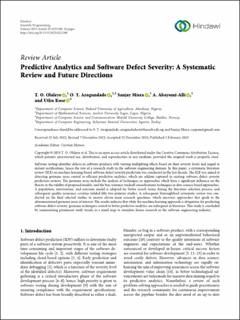| dc.contributor.author | Olaleye, T. O. | |
| dc.contributor.author | Arogundade, O. T. | |
| dc.contributor.author | Misra, Sanjay | |
| dc.contributor.author | Abayomi-Alli, A. | |
| dc.contributor.author | Kose, Utku | |
| dc.date.accessioned | 2023-11-03T09:01:44Z | |
| dc.date.available | 2023-11-03T09:01:44Z | |
| dc.date.created | 2023-02-03T13:27:55Z | |
| dc.date.issued | 2023 | |
| dc.identifier.citation | Scientific Programming. 2023, 2023, Artikkel 6221388. | en_US |
| dc.identifier.issn | 1058-9244 | |
| dc.identifier.uri | https://hdl.handle.net/11250/3100426 | |
| dc.description.abstract | Software testing identifies defects in software products with varying multiplying effects based on their severity levels and sequel to instant rectifications, hence the rate of a research study in the software engineering domain. In this paper, a systematic literature review (SLR) on machine learning-based software defect severity prediction was conducted in the last decade. The SLR was aimed at detecting germane areas central to efficient predictive analytics, which are seldom captured in existing software defect severity prediction reviews. The germane areas include the analysis of techniques or approaches which have a significant influence on the threats to the validity of proposed models, and the bias-variance tradeoff considerations techniques in data science-based approaches. A population, intervention, and outcome model is adopted for better search terms during the literature selection process, and subsequent quality assurance scrutiny yielded fifty-two primary studies. A subsequent thoroughbred systematic review was conducted on the final selected studies to answer eleven main research questions, which uncovers approaches that speak to the aforementioned germane areas of interest. The results indicate that while the machine learning approach is ubiquitous for predicting software defect severity, germane techniques central to better predictive analytics are infrequent in literature. This study is concluded by summarizing prominent study trends in a mind map to stimulate future research in the software engineering industry. | en_US |
| dc.language.iso | eng | en_US |
| dc.publisher | Hindawi | en_US |
| dc.rights | Navngivelse 4.0 Internasjonal | * |
| dc.rights.uri | http://creativecommons.org/licenses/by/4.0/deed.no | * |
| dc.title | Predictive Analytics and Software Defect Severity: A Systematic Review and Future Directions | en_US |
| dc.type | Peer reviewed | en_US |
| dc.type | Journal article | en_US |
| dc.description.version | publishedVersion | en_US |
| dc.rights.holder | © 2023 T. O. Olaleye et al. | en_US |
| dc.subject.nsi | VDP::Teknologi: 500::Informasjons- og kommunikasjonsteknologi: 550 | en_US |
| dc.source.volume | 2023 | en_US |
| dc.source.journal | Scientific Programming | en_US |
| dc.identifier.doi | 10.1155/2023/6221388 | |
| dc.identifier.cristin | 2122798 | |
| dc.source.articlenumber | 6221388 | en_US |
| cristin.ispublished | true | |
| cristin.fulltext | original | |
| cristin.qualitycode | 1 | |

